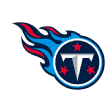Players who will score more TDs in 2018
Mike Clay
ESPN INSIDER
Football statistics are extremely hard to predict, but history continues to show that projecting touchdown regression to the mean is significantly easier than you might imagine.
From 2007 to 2016, there were 128 instances in which a wide receiver or tight end scored fewer than five touchdowns on 50-plus offensive touches one season before getting 50-plus touches again the very next season. In those cases, 89 players (69.5 percent) ended up scoring more touchdowns in that subsequent season.
<offer style="box-sizing: border-box;"></offer>Focusing in on the 39 players in that group who scored fewer than three touchdowns during the first year, a full 33 of them (84.6 percent) scored more touchdowns the next season. Of the 16 cases where players scored only one touchdown or none at all, 14 times (87.5 percent) those players found the end zone more often the next year. Oddly enough, Jason Avant (2010-11 and 2011-12) was responsible for both failures in this category.
We see similar results if we run this test on running backs. There were 57 instances in which a back failed to eclipse seven touchdowns on 200-plus touches before managing 200-plus touches again the following season. Of those 57 instances, 45 times (78.9 percent) players scored more touchdowns the second time around. Interestingly, there were seven backs who failed to eclipse two touchdowns in the first year but each scored five-plus times in the subsequent season. The average second-year touchdown total at this position was 8.6.
If you skipped all that, or just tuned out while scanning over all those numbers, the point here is simple: NFL players tend to bounce back -- and often in a big way -- when they post an unusually low touchdown number in one season while seeing similar playing time the following season.
Note: In this piece, I'll be referencing OTD, which is a statistic that weighs every carry/target and converts the data into a single number that indicates a player's scoring opportunity. Put another way, it's how many touchdowns a league-average player would have scored with the exact same opportunity as the player being discussed. This analysis is limited to regular-season rushing and receiving data.
With all of that in mind, a careful examination of each of the following players usage in 2017 indicates that we should expect an increase in scoring production from them in 2018.
 Julio Jones, Atlanta Falcons (2017: 3 TD, 8.6 OTD): Each and every year, a poster boy for touchdown regression to the mean emerges. In 2018, Jones is that guy. Jones scored only three times last season and has reached the end zone eight times only once since 2013. However, a closer look at Jones' career shows an interesting trend. During his first two NFL seasons, Jones scored 18 touchdowns (11.8 OTD) and handled 25 end zone targets. From 2013 to 2016, he scored 22 touchdowns (20.3 OTD) with 20 end zone targets. Last season, Jones was limited to three scores despite an 8.6 OTD (fourth highest among wide receivers) and 16 end zone targets (seventh).
Julio Jones, Atlanta Falcons (2017: 3 TD, 8.6 OTD): Each and every year, a poster boy for touchdown regression to the mean emerges. In 2018, Jones is that guy. Jones scored only three times last season and has reached the end zone eight times only once since 2013. However, a closer look at Jones' career shows an interesting trend. During his first two NFL seasons, Jones scored 18 touchdowns (11.8 OTD) and handled 25 end zone targets. From 2013 to 2016, he scored 22 touchdowns (20.3 OTD) with 20 end zone targets. Last season, Jones was limited to three scores despite an 8.6 OTD (fourth highest among wide receivers) and 16 end zone targets (seventh).
The gap between his actual touchdown total and his OTD was easily the highest in the NFL. Incredibly, Jones hauled in only one of his 16 end zone looks. He had been 14-of-45 entering the season. Jones has exceeded his expected touchdown total throughout his career, but simply went through a stretch where he wasn't getting the ball much near the goal line. That changed in a big way in Steve Sarkisian's first season as offensive coordinator. Assuming Jones remains a priority target near the end zone in 2018, it's fair to expect a major rebound in the touchdown department.
2018 projection: 8 TD
 Mike Evans, Tampa Bay Buccaneers (2017: 5 TD, 9.3 OTD): Now four seasons into his career, Evans has been about as volatile as a receiver can be in the touchdown department. Despite relatively consistent OTD marks (7.9, 8.3, 10.4, 9.3), Evans' touchdown totals have been all over the map (12, 3, 12 and 5, respectively.). Evans has racked up a league-high 73 end zone targets, top 10 in the category each of his four seasons. Evans has been a strong fantasy producer thus far, but he continues to fall short of the expectations that come with his massive volume. Still, there's little reason to expect a drop in usage in 2018 and, at 6-foot-5, he'll continue to be a popular target near the goal line.
Mike Evans, Tampa Bay Buccaneers (2017: 5 TD, 9.3 OTD): Now four seasons into his career, Evans has been about as volatile as a receiver can be in the touchdown department. Despite relatively consistent OTD marks (7.9, 8.3, 10.4, 9.3), Evans' touchdown totals have been all over the map (12, 3, 12 and 5, respectively.). Evans has racked up a league-high 73 end zone targets, top 10 in the category each of his four seasons. Evans has been a strong fantasy producer thus far, but he continues to fall short of the expectations that come with his massive volume. Still, there's little reason to expect a drop in usage in 2018 and, at 6-foot-5, he'll continue to be a popular target near the goal line.
2018 projection: 8 TD
 DeVante Parker, Miami Dolphins (2017: 1 TD, 4.8 OTD): Parker is a bigger receiver at 6-foot-3, 218 pounds, but simply hasn't done much damage in the touchdown department through three NFL seasons. Prior to last season, volume was the primary culprit. Parker scored seven touchdowns (6.7 OTD) and handled 12 end zone targets during his first two seasons. In 2017, however, Parker hit career-highs in targets (96), end zone targets (9) and OTD (4.8), but was limited to just one score. Parker has caught only 4-of-21 career end zone targets. Jarvis Landry is gone, which will allow Parker even more work in 2018. Add to the mix some touchdown regression to the mean and he makes for an intriguing post-hype target. I know, we say this every year.
DeVante Parker, Miami Dolphins (2017: 1 TD, 4.8 OTD): Parker is a bigger receiver at 6-foot-3, 218 pounds, but simply hasn't done much damage in the touchdown department through three NFL seasons. Prior to last season, volume was the primary culprit. Parker scored seven touchdowns (6.7 OTD) and handled 12 end zone targets during his first two seasons. In 2017, however, Parker hit career-highs in targets (96), end zone targets (9) and OTD (4.8), but was limited to just one score. Parker has caught only 4-of-21 career end zone targets. Jarvis Landry is gone, which will allow Parker even more work in 2018. Add to the mix some touchdown regression to the mean and he makes for an intriguing post-hype target. I know, we say this every year.
2018 projection: 5 TD
 Marquise Goodwin, San Francisco 49ers (2017: 2 TD, 5.7 OTD): Along with his teammate Pierre Garcon, (2017: 0 TD, 1.0 OTD), through Week 9 last season, the pair of 49ers receivers had combined for 121 targets, 62 receptions, 917 yards -- and zero touchdowns (4.3 OTD). Garcon missed the rest of the season and Goodwin found paydirt twice down the stretch. Still, it was pretty evident that the team's two best receivers were unlucky in the scoring department. In fact, among the 40 players who handled eight-plus end zone targets last season, Goodwin was the only one who failed to catch even one (he had 10 end zone targets).
Marquise Goodwin, San Francisco 49ers (2017: 2 TD, 5.7 OTD): Along with his teammate Pierre Garcon, (2017: 0 TD, 1.0 OTD), through Week 9 last season, the pair of 49ers receivers had combined for 121 targets, 62 receptions, 917 yards -- and zero touchdowns (4.3 OTD). Garcon missed the rest of the season and Goodwin found paydirt twice down the stretch. Still, it was pretty evident that the team's two best receivers were unlucky in the scoring department. In fact, among the 40 players who handled eight-plus end zone targets last season, Goodwin was the only one who failed to catch even one (he had 10 end zone targets).
Goodwin is only 5-foot-9 and has never scored more than three touchdowns in a season, so we can't expect gigantic production in this category. Similarly, Garcon has been around since 2008, but has never eclipsed six scores in a season. Some regression to the mean, combined with a quarterback upgrade to Jimmy Garoppolo, should help both men improve their scoring rate in 2018.
2018 projection: Goodwin - 5 TD, Garcon - 4 TD
 Delanie Walker, Tennessee Titans (2017: 4 TD, 6.9 OTD): Starting with 2013, Walker's OTD marks over the past five seasons are as follows: 6.0, 6.0, 5.9, 5.8, 5.8. His touchdown totals during that span? 6, 4, 6, 7 and 3. Needless to say, 2017 stands out as the largest exception. That's even more so the case when you consider that Walker's 12 end zone targets last season were a career-high by four. Walker caught only two (or 16.7 percent) of last year's end zone looks after catching 42.1 percent (16-of-38) during the previous decade. The 34-year-old should find paydirt far more often in 2018.
Delanie Walker, Tennessee Titans (2017: 4 TD, 6.9 OTD): Starting with 2013, Walker's OTD marks over the past five seasons are as follows: 6.0, 6.0, 5.9, 5.8, 5.8. His touchdown totals during that span? 6, 4, 6, 7 and 3. Needless to say, 2017 stands out as the largest exception. That's even more so the case when you consider that Walker's 12 end zone targets last season were a career-high by four. Walker caught only two (or 16.7 percent) of last year's end zone looks after catching 42.1 percent (16-of-38) during the previous decade. The 34-year-old should find paydirt far more often in 2018.
2018 projection: 7 TD
 Michael Thomas, New Orleans Saints (2017: 5 TD, 5.2 OTD): Thomas has been one of the league's most-productive wide receivers during his two NFL seasons, but he's racked up only 12 end zone targets during the span. Thomas was fortunate to score nine touchdowns as a rookie, especially when you consider his 5.2 OTD. Interestingly, his OTD was once again 5.2 last season, but his touchdown total dipped down to five. The Saints scored 53 percent of their offensive touchdowns through the air last season after averaging 73 percent over the previous seven seasons. That's a number likely to rise a bit in 2018. Thomas is in line for a rebound, as he's 6-foot-3 and a heavily targeted receiver in one of the league's top offenses.
Michael Thomas, New Orleans Saints (2017: 5 TD, 5.2 OTD): Thomas has been one of the league's most-productive wide receivers during his two NFL seasons, but he's racked up only 12 end zone targets during the span. Thomas was fortunate to score nine touchdowns as a rookie, especially when you consider his 5.2 OTD. Interestingly, his OTD was once again 5.2 last season, but his touchdown total dipped down to five. The Saints scored 53 percent of their offensive touchdowns through the air last season after averaging 73 percent over the previous seven seasons. That's a number likely to rise a bit in 2018. Thomas is in line for a rebound, as he's 6-foot-3 and a heavily targeted receiver in one of the league's top offenses.
2018 projection: 9 TD
 Jay Ajayi, Philadelphia Eagles (2017: 2 TD, 2.5 OTD): Ajayi failed to score on 152 touches with Miami last season, primarily because the team did not run the ball a single time inside the opponent's 5-yard line while he was on the roster. With the Eagles, Ajayi deferred some goal-line work to Corey Clement and was left with two scores on 80 touches. Despite his large frame (6-foot, 228 pounds) and post-contact dominance (his career 2.37 YAC is No. 1 overall since he entered the league), Ajayi has been limited to nine carries inside-the-5 during his three seasons. He scored on five of those plays. Though a long resume of limited workload near the goal line is a concern, Ajayi is a candidate for 250-plus touches in the high-scoring Eagles' offense. That should allow him to triple his touchdown total from last season.
Jay Ajayi, Philadelphia Eagles (2017: 2 TD, 2.5 OTD): Ajayi failed to score on 152 touches with Miami last season, primarily because the team did not run the ball a single time inside the opponent's 5-yard line while he was on the roster. With the Eagles, Ajayi deferred some goal-line work to Corey Clement and was left with two scores on 80 touches. Despite his large frame (6-foot, 228 pounds) and post-contact dominance (his career 2.37 YAC is No. 1 overall since he entered the league), Ajayi has been limited to nine carries inside-the-5 during his three seasons. He scored on five of those plays. Though a long resume of limited workload near the goal line is a concern, Ajayi is a candidate for 250-plus touches in the high-scoring Eagles' offense. That should allow him to triple his touchdown total from last season.
2018 projection: 6 TD
 Adam Thielen, Minnesota Vikings (2017: 4 TD, 5.4 OTD): Thielen enjoyed a bit of a breakout season with 69 catches for 967 yards in 2016, but took his game to another level with a 91-1,276 line in 2017. Despite the big step forward, Thielen's touchdown total actually fell from five to four last season. That was also despite a jump in OTD from 3.7 to 5.4 and an increase in end zone targets from four to nine. Thielen's underwhelming usage near the goal line is a concern, but size is on his side (6-foot-2). Plus, both Stefon Diggs and Kyle Rudolph are candidates for slight dips in the scoring department this season. Bet on a career-high in touchdowns for Thielen in 2018.
Adam Thielen, Minnesota Vikings (2017: 4 TD, 5.4 OTD): Thielen enjoyed a bit of a breakout season with 69 catches for 967 yards in 2016, but took his game to another level with a 91-1,276 line in 2017. Despite the big step forward, Thielen's touchdown total actually fell from five to four last season. That was also despite a jump in OTD from 3.7 to 5.4 and an increase in end zone targets from four to nine. Thielen's underwhelming usage near the goal line is a concern, but size is on his side (6-foot-2). Plus, both Stefon Diggs and Kyle Rudolph are candidates for slight dips in the scoring department this season. Bet on a career-high in touchdowns for Thielen in 2018.
2018 projection: 7 TD
 Emmanuel Sanders, Denver Broncos (2017: 2 TD, 3.4 OTD): Sanders missed four games last season, but he was well on his way to disappointing touchdown production well before the injury. Sanders averaged 6.5 touchdowns per game (26 touchdowns, 27.3 OTD) during the 2013-16 seasons, prior to a major step back in 2017. Sanders was limited to five end zone targets last season -- his lowest since 2012 -- but is a candidate for a rebound in the category now that he's healthy and Denver has an improved quarterback situation.
Emmanuel Sanders, Denver Broncos (2017: 2 TD, 3.4 OTD): Sanders missed four games last season, but he was well on his way to disappointing touchdown production well before the injury. Sanders averaged 6.5 touchdowns per game (26 touchdowns, 27.3 OTD) during the 2013-16 seasons, prior to a major step back in 2017. Sanders was limited to five end zone targets last season -- his lowest since 2012 -- but is a candidate for a rebound in the category now that he's healthy and Denver has an improved quarterback situation.
2018 projection: 5 TD
 Sterling Shepard, New York Giants (2017: 2 TD, 3.9 OTD): At this time last year, Shepard was a strong candidate for a dip in touchdowns. As a rookie, he overachieved in the category, scoring eight touchdowns (5.1 OTD) despite only seeing seven end zone targets. Last season, Shepard overcorrected a bit, scoring twice (3.9 OTD) and handling only three end zone looks. Odell Beckham Jr., Evan Engram and Saquon Barkley are all in the fold, so Shepard isn't a candidate for a huge touchdown total as an undersized slot man. Still, he figures to settle into the 4 to 6 range.
Sterling Shepard, New York Giants (2017: 2 TD, 3.9 OTD): At this time last year, Shepard was a strong candidate for a dip in touchdowns. As a rookie, he overachieved in the category, scoring eight touchdowns (5.1 OTD) despite only seeing seven end zone targets. Last season, Shepard overcorrected a bit, scoring twice (3.9 OTD) and handling only three end zone looks. Odell Beckham Jr., Evan Engram and Saquon Barkley are all in the fold, so Shepard isn't a candidate for a huge touchdown total as an undersized slot man. Still, he figures to settle into the 4 to 6 range.
2018 projection: 5 TD
 Tyler Lockett, Seattle Seahawks (2017: 2 TD plus a return score, 4.5 OTD): After scoring six offensive touchdowns (3.0 OTD) as a rookie, Lockett has combined for four scores (7.0 OTD) over the past two seasons. Lockett's 4.5 OTD last season was easily the highest of his short career, as were his seven end zone targets. Jimmy Graham (10.3 OTD, 19 end zone targets) and Paul Richardson (4.1 OTD, seven end zone targets) are both gone from last season's roster, which positions Lockett for even more work in 2018. Lockett's frame (5-foot-10, 182 pounds) could limit his scoring ceiling, but there's clearly room for more production. Additionally, his heavy workload as a returner, which has allowed him three career special-teams scores, isn't expected to change.
Tyler Lockett, Seattle Seahawks (2017: 2 TD plus a return score, 4.5 OTD): After scoring six offensive touchdowns (3.0 OTD) as a rookie, Lockett has combined for four scores (7.0 OTD) over the past two seasons. Lockett's 4.5 OTD last season was easily the highest of his short career, as were his seven end zone targets. Jimmy Graham (10.3 OTD, 19 end zone targets) and Paul Richardson (4.1 OTD, seven end zone targets) are both gone from last season's roster, which positions Lockett for even more work in 2018. Lockett's frame (5-foot-10, 182 pounds) could limit his scoring ceiling, but there's clearly room for more production. Additionally, his heavy workload as a returner, which has allowed him three career special-teams scores, isn't expected to change.
2018 projection: 4 TD (5 TD including returns)
 Isaiah Crowell, New York Jets (2017: 2 TD, 5.5 OTD): Crowell found the end zone twice last season after scoring at least five times during each of his first three seasons in the league. He totaled 20 touchdowns (15.0 OTD) and 17 carries inside the opponent's 5-yard line during the span. Crowell hit a bump in the road during Cleveland's 0-16 season. His 5.5 OTD ranked 23rd at the position and he carried the ball five times inside-the-5. Now in New York, Crowell is easily the Jets' biggest back and, though he figures to be the team's primary goal-line back, it's worth noting that Bilal Powell easily led the team with nine carries inside-the-5 last season. Matt Forte was the next closest running back with three, and returning situational back Elijah McGuire handled one.
Isaiah Crowell, New York Jets (2017: 2 TD, 5.5 OTD): Crowell found the end zone twice last season after scoring at least five times during each of his first three seasons in the league. He totaled 20 touchdowns (15.0 OTD) and 17 carries inside the opponent's 5-yard line during the span. Crowell hit a bump in the road during Cleveland's 0-16 season. His 5.5 OTD ranked 23rd at the position and he carried the ball five times inside-the-5. Now in New York, Crowell is easily the Jets' biggest back and, though he figures to be the team's primary goal-line back, it's worth noting that Bilal Powell easily led the team with nine carries inside-the-5 last season. Matt Forte was the next closest running back with three, and returning situational back Elijah McGuire handled one.
<article class="ad-300" style='background-color: transparent; box-sizing: border-box; clear: both; color: rgb(0, 0, 0); display: block; float: right; font-family: Georgia,"Times New Roman",Times,serif; font-size: 16px; font-style: normal; font-variant: normal; font-weight: 400; letter-spacing: normal; margin-bottom: 10px; margin-left: 10px; margin-right: 0px; margin-top: 0px; orphans: 2; overflow: hidden; position: relative; text-align: left; text-decoration: none; text-indent: 0px; text-transform: none; -webkit-text-stroke-width: 0px; white-space: normal; word-spacing: 0px; z-index: 1000026;'><iframe width="7" height="6" id="MoatPxIOPT4_11761064" scrolling="no" style="border-bottom-style: none; border-left-style: none; border-right-style: none; border-top-style: none; box-sizing: border-box; height: 6px; left: 0px; position: absolute; top: 0px; width: 7px; z-index: -9999;"></iframe>From 2007 to 2016, there were 128 instances in which a wide receiver or tight end scored fewer than five touchdowns on 50-plus offensive touches one season before getting 50-plus touches again the very next season. In those cases, 89 players (69.5 percent) ended up scoring more touchdowns in that subsequent season.
<offer style="box-sizing: border-box;"></offer>Focusing in on the 39 players in that group who scored fewer than three touchdowns during the first year, a full 33 of them (84.6 percent) scored more touchdowns the next season. Of the 16 cases where players scored only one touchdown or none at all, 14 times (87.5 percent) those players found the end zone more often the next year. Oddly enough, Jason Avant (2010-11 and 2011-12) was responsible for both failures in this category.
We see similar results if we run this test on running backs. There were 57 instances in which a back failed to eclipse seven touchdowns on 200-plus touches before managing 200-plus touches again the following season. Of those 57 instances, 45 times (78.9 percent) players scored more touchdowns the second time around. Interestingly, there were seven backs who failed to eclipse two touchdowns in the first year but each scored five-plus times in the subsequent season. The average second-year touchdown total at this position was 8.6.
If you skipped all that, or just tuned out while scanning over all those numbers, the point here is simple: NFL players tend to bounce back -- and often in a big way -- when they post an unusually low touchdown number in one season while seeing similar playing time the following season.
Note: In this piece, I'll be referencing OTD, which is a statistic that weighs every carry/target and converts the data into a single number that indicates a player's scoring opportunity. Put another way, it's how many touchdowns a league-average player would have scored with the exact same opportunity as the player being discussed. This analysis is limited to regular-season rushing and receiving data.
With all of that in mind, a careful examination of each of the following players usage in 2017 indicates that we should expect an increase in scoring production from them in 2018.

The gap between his actual touchdown total and his OTD was easily the highest in the NFL. Incredibly, Jones hauled in only one of his 16 end zone looks. He had been 14-of-45 entering the season. Jones has exceeded his expected touchdown total throughout his career, but simply went through a stretch where he wasn't getting the ball much near the goal line. That changed in a big way in Steve Sarkisian's first season as offensive coordinator. Assuming Jones remains a priority target near the end zone in 2018, it's fair to expect a major rebound in the touchdown department.
2018 projection: 8 TD

2018 projection: 8 TD

2018 projection: 5 TD

Goodwin is only 5-foot-9 and has never scored more than three touchdowns in a season, so we can't expect gigantic production in this category. Similarly, Garcon has been around since 2008, but has never eclipsed six scores in a season. Some regression to the mean, combined with a quarterback upgrade to Jimmy Garoppolo, should help both men improve their scoring rate in 2018.
2018 projection: Goodwin - 5 TD, Garcon - 4 TD

2018 projection: 7 TD

2018 projection: 9 TD

2018 projection: 6 TD

2018 projection: 7 TD

2018 projection: 5 TD

2018 projection: 5 TD

2018 projection: 4 TD (5 TD including returns)

<iframe width="7" height="6" id="MoatPxIOPT4_54043807" scrolling="no" style="border-bottom-style: none; border-left-style: none; border-right-style: none; border-top-style: none; box-sizing: border-box; height: 6px; left: 293px; position: absolute; top: 0px; width: 7px; z-index: -9999;"></iframe>
<iframe width="7" height="6" id="MoatPxIOPT4_75005419" scrolling="no" style="border-bottom-style: none; border-left-style: none; border-right-style: none; border-top-style: none; box-sizing: border-box; height: 6px; left: 0px; position: absolute; top: 243px; width: 7px; z-index: -9999;"></iframe>
<iframe width="7" height="6" id="MoatPxIOPT4_52572094" scrolling="no" style="border-bottom-style: none; border-left-style: none; border-right-style: none; border-top-style: none; box-sizing: border-box; height: 6px; left: 293px; position: absolute; top: 243px; width: 7px; z-index: -9999;"></iframe>
<iframe name="google_ads_iframe_/6444/espn.com/fantasy/football/story_7" width="300" height="250" title="3rd party ad content" id="google_ads_iframe_/6444/espn.com/fantasy/football/story_7" frameborder="0" marginwidth="0" marginheight="0" scrolling="no" style="border-bottom-color: rgb(0, 0, 0); border-bottom-style: none; border-bottom-width: 0px; border-image-outset: 0; border-image-repeat: stretch; border-image-slice: 100%; border-image-source: none; border-image-width: 1; border-left-color: rgb(0, 0, 0); border-left-style: none; border-left-width: 0px; border-right-color: rgb(0, 0, 0); border-right-style: none; border-right-width: 0px; border-top-color: rgb(0, 0, 0); border-top-style: none; border-top-width: 0px; box-sizing: border-box; vertical-align: bottom;"></iframe>
</article>
<iframe name="google_ads_iframe_/6444/espn.com/fantasy/football/story_7" width="300" height="250" title="3rd party ad content" id="google_ads_iframe_/6444/espn.com/fantasy/football/story_7" frameborder="0" marginwidth="0" marginheight="0" scrolling="no" style="border-bottom-color: rgb(0, 0, 0); border-bottom-style: none; border-bottom-width: 0px; border-image-outset: 0; border-image-repeat: stretch; border-image-slice: 100%; border-image-source: none; border-image-width: 1; border-left-color: rgb(0, 0, 0); border-left-style: none; border-left-width: 0px; border-right-color: rgb(0, 0, 0); border-right-style: none; border-right-width: 0px; border-top-color: rgb(0, 0, 0); border-top-style: none; border-top-width: 0px; box-sizing: border-box; vertical-align: bottom;"></iframe>
</article>
2018 projection: 5 TD
 Terrance Williams, Dallas Cowboys (2017: 0 TD, 3.0 OTD): Williams had scored at least three touchdowns during his first four NFL seasons before failing to find the end zone in 2017. Williams' seven end zone targets ranked 30th at the position and Dez Bryant was the only Cowboys' player with more. Williams scored 20 touchdowns with a 17.3 OTD during his first three seasons, so a rebound season is likely. That, of course, assumes he sustains a significant role with Cole Beasley, Allen Hurns and Michael Gallup also in the mix.
Terrance Williams, Dallas Cowboys (2017: 0 TD, 3.0 OTD): Williams had scored at least three touchdowns during his first four NFL seasons before failing to find the end zone in 2017. Williams' seven end zone targets ranked 30th at the position and Dez Bryant was the only Cowboys' player with more. Williams scored 20 touchdowns with a 17.3 OTD during his first three seasons, so a rebound season is likely. That, of course, assumes he sustains a significant role with Cole Beasley, Allen Hurns and Michael Gallup also in the mix.
2018 projection: 3 TD<strike></strike>
<strike></strike><strike></strike>
2018 projection: 3 TD<strike></strike>





